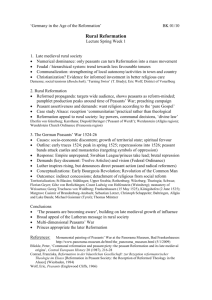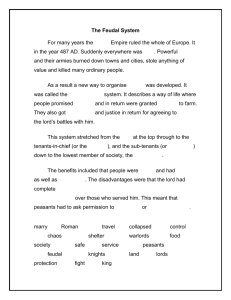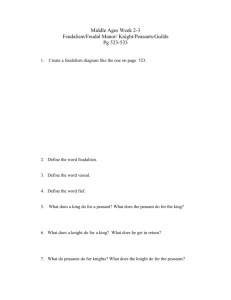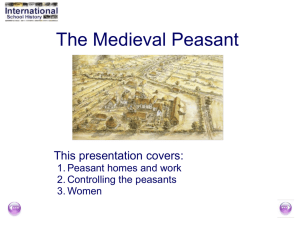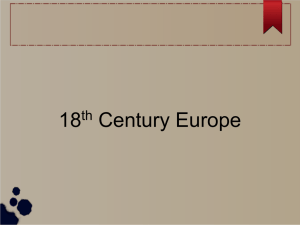THE RADICAL GOSPEL: IDEOLOGICAL CONTINUITY FROM THE PROTESTANT REFORMATION TO THE
advertisement
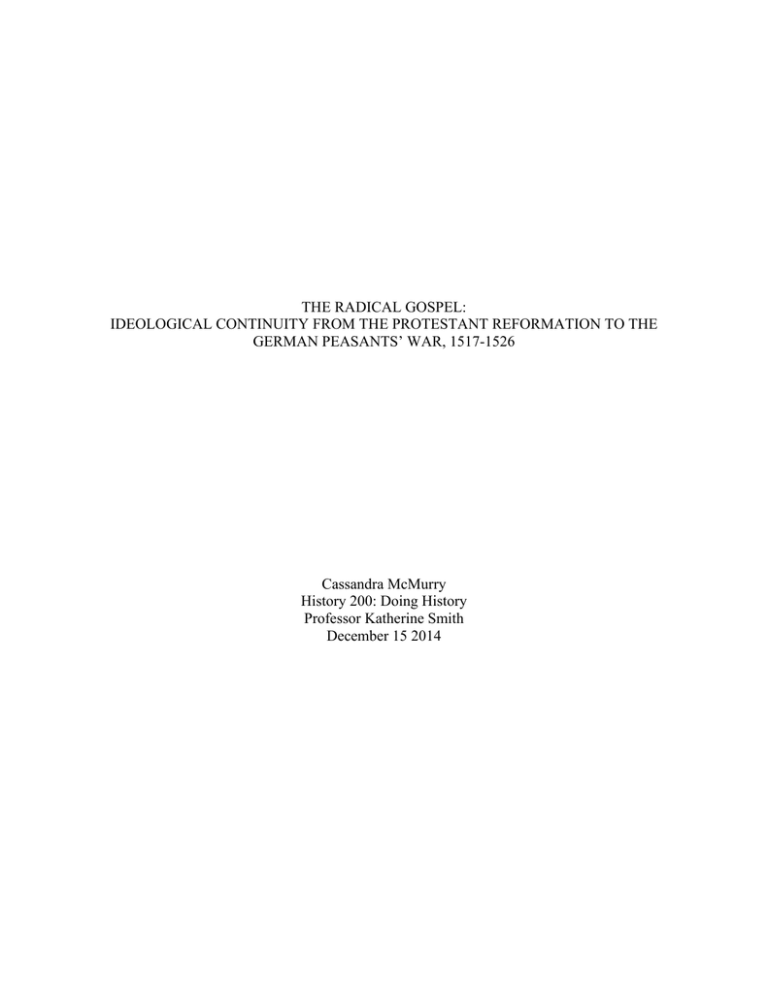
THE RADICAL GOSPEL: IDEOLOGICAL CONTINUITY FROM THE PROTESTANT REFORMATION TO THE GERMAN PEASANTS’ WAR, 1517-1526 Cassandra McMurry History 200: Doing History Professor Katherine Smith December 15 2014 1 The rhetoric of the Protestant Reformation, while advocating a new conception of piety and worship that flew in the face of traditional Catholic doctrine, also shaped a new conception of a social group often considered apolitical, simplistic, and passive: the peasantry. To help garner support for their cause, beginning in 1520 Reformation adherents (Reformers) began to represent the peasantry with a fictional peasant they named Karsthans, who frequently appeared in distributed woodcuts as part of Reformation propaganda. Karsthans is commonly depicted standing at the literal center of religious change—at the side of Martin Luther himself—as a powerful and devoted peasant soldier, wielding a flail to defend the word of God.1 Scholars such as R. W. Scriber have termed this new understanding of the peasants’ role in Reform the birth of the ‘Evangelical Peasant’ as a “presiding guardian” over the new religious rhetoric of the Protestant Reformation.2 The Reformers aimed to dismantle the power of the Catholic hierarchical system by advocating that the faithful make direct contact with God rather than going through a priest by means of confession, an egalitarian doctrine based on their new interpretation of the Bible. These theologians imagined that the political impetus of their challenge to hegemonic Catholic tradition would come from the lowest orders of society, the common man was thought to be “closer to God” and therefore distinctly qualified to lead a Protestant movement to defend Scripture.3 In late 1524 and early 1525 the peasants of the region which is now Germany, Austria, and Switzerland rose against their lords, demanding changes to social and political institutions such as the church and the lord-vassal relationship, as well as advocating community governance. The nature of this peasant movement and its relation to the Reformation is 1 R.W Scribner, “Images of the Peasant, 1514-1525,” in The German Peasant War of 1525, ed. Janos Bak (London: Frank Cass, 1976), 33. 2 Ibid., 33. 3 Ibid., 30. 2 controversial and complex; each group was multifaceted and heterogeneous and the distinctions that separated Reformers from peasant rebels were, although significant, often less universal than they have often been portrayed. Some scholars, such as Peter Blickle, have argued that the peasants merely adopted theology to suit their political purposes, and others, like Adolf Laube, argue that the Reformation and the Peasants’ War existed reciprocally, with one building upon the theories of the other.4 Distinct to most secondary literature, however, is the notion that the Reformation and the Peasants’ War were separate phenomena, perhaps influencing one another but ultimately remaining separate, both ideologically and practically. The political and theological writings of the German Peasants’ War, however, suggest that peasant ideology had direct continuity with contemporary Reformation theology—the basis of peasant doctrine was not political or economic, but Scriptural. The Peasants’ War, then, began as a kind of Peasants’ Reformation, with peasants doing what Reformation propagandists had always envisioned: taking up arms to defend the word of God. But peasants found in their radical gospel secular political applications that the Reformers did not, and this Scriptural politics fuelled the radically egalitarian and anti-feudal doctrines of the peasant rebels of 1524-1526. While the Reformation’s primary goal was, of course, the establishment of Protestantism, this more egalitarian religious doctrine that placed average people in direct contact with God also implied certain structural changes along religious lines. Martin Luther (1483-1546), perhaps the most famous and influential Reformation theologian states in his famous “Ninety-five Theses” that there is no Biblical basis for the pope’s claim that souls could be saved by paying the church, but rather that “gain and avarice” led the pope to thus exploit the people, constituting 4 Peter Blickle, The Revolution of 1525: The German Peasants’ War from a New Perspective, trans. Thomas A. Brady and H.C. Erik Midelfort (London: Johns Hopkins, 1981); Adolf Laube, “Social Arguments in Early Reformation Pamphlets and Their Significance for the German Peasants’ War” in Social History 12 no. 3 (1976): 361-378. 3 usury.5 Admittedly, this demand does not directly affect the secular government, as it more directly relates to the Protestant rejection of communicating with God using the clergy as an intermediary. However, that this demand would deal as much with economic practices as it does doctrinal debate, especially the economic practices of arguably the most powerful institution in the medieval world, indicates the radical potential of even the earliest (and most conservative) Reformation theology. Other Reformers, such as Thomas Müntzer (ca. 1489-1525), the preacher turned peasant leader, wrote even more politically charged treatises during the early Reformation. In his “Prague Protest,” written in 1521, Müntzer described his view that parsons were as exploitative of the common people as lords and that the morality of the Church had declined because the parsons only had an interest in gaining a “ruling position” within the Church.6 These views suggest not only that the medieval Catholic Church was felt to be extremely corrupt, but also that certain Reformers saw a connection between ecclesiastical abuse and political inequality (i.e. feudal vassalage), as evidenced by Müntzer’s equivocation of secular and religious oppression. Although some Reformation theologians confined their criticisms strictly to the religious realm while others took broader views that implied secular as well as religious corruption, both cases indicate that, as Laube argues, the Reformation was a force for societal change beyond the internal structure of the Catholic Church.7 Just seven years after Luther tacked his famous “Ninety-five Theses” to the door of the Wittenberg Church as a challenge to traditional Catholicism, the peasants of south-central 5 Martin Luther, “Disputation of Doctor Martin Luther On The Power and Efficacy of Indulgences,” [commonly referred to as the “Ninety-five Theses”] in The Works of Martin Luther With Introduction and Notes, trans. C.M. Jacobs (Philadelphia: A.J. Holmann Company, 1915), HTML e-book. http://www.gutenberg.org/cache/epub/31604/pg31604.html. 6 Thomas Müntzer, “The Prague Protest: A Protest about the Condition of the Bohemians,” in Revelation and Revolution: Basic Writings of Thomas Müntzer, ed. and trans. Michael G. Baylor (London and Toronto: Assoicated University Press, 1993), 56-59. 7 Laube, 362. 4 Germany began to rise against their lords, justifying their rebellions with a doctrine of “godly law” that emerged from their interpretation of Scripture.8 The peasants’ anger at the feudal system and the subsequent violence they engaged in to fight for their liberation has been commonly understood as fundamentally economic in origin, with the gospel serving as a convenient extralegal justification for squarely secular demands.9A close examination of both peasant and Reformation texts, however, indicates that peasant anti-feudalism actually originated from Scriptural ideas that were interpreted to have secular meaning. This continuity between Reformation and peasant demands fundamentally lies in the fact that peasant doctrine was grounded in Protestant theological premises that were similar or even identical to the pious egalitarian ideas being expressed by the Reformers. The “Twelve Articles,” a list of grievances written by the Christian Union (an organization of the rebellious peasants of Swabia) in March of 1525, clearly articulates that the premises with which peasants justified their disorder were primarily theological. The peasants of the Christian Union stated that the goal of their organization was to create a society that would “hear the Gospel and live according to it.” 10 Significantly, this desire is strikingly similar in meaning to Luther’s plea in the “Ninety-five Theses” that “Christians [must]…be diligent in following Christ,”11 indicating that peasants and Reformers both used a similar interpretation of the gospel as justification for the societal changes 8 Thomas A. Brady, Jr. and H.C. Erik Midelfort, translator’s introduction to The Revolution of 1525: The German Peasants’ War from a New Perspective, trans. Thomas A. Brady and H.C. Erik Midelfort (London: Johns Hopkins, 1981), 9. 9 The interpretation that peasants merely exploited religious thought to serve purely political aims was first popularized by Marxist historians, most famously by Friedrich Engels, who argued that the Peasants’ War’s religious causes were insignificant, but rather economic grievances were the most significant factor in producing the uprisings. (See Friedrich Engels, The German Revolutions: The Peasant War in Germany ed. Leonard Krieger, [Chicago and London: University of Chicago Press, 1967].) This view is still popular, albeit phrased in non-Marxist terms, as evidenced by Peter Blickle’s support of it in The Revolution of 1525: The German Peasants’ War from a New Perspective. 10 Sebastian Lotzer and Cristoph Schappeler, “The Twelve Articles,” in The German Peasants’ War: A History in Documents, ed. and trans. Tom Scott and Bob Scribner (London: Humanities Press International, 1991), 253. 11 Luther, “On the Power and Efficacy of Indulgences.” 5 they demanded. The “Twelve Articles” also have many concrete demands in common with the writings of well-known Reformers. Article Two, for example, asserts the right of the community to select a pastor who will “preach the holy Gospel to us purely and cleanly,” that is, without “human additions” made by the corrupt Catholic Church.12 This demand is nearly identical to Müntzer’s call for the removal of the “treacherous parsons…[who] lock up Scripture and say that God must not speak to people in his own person.”13 That peasants would take an interest in affairs of the Church that had no secular relevance indicates that the historiographical view that the peasants merely exploited theology to serve their political purposes is due for reexamination. In reality, the peasants’ use of a Protestant theological framework gave the movement its origins not as a Peasants’ War, but rather as a Peasants’ Reformation. Not only did peasant documents prominently feature theological demands, but the secular and political grievances that the peasants presented also originated from fundamentally Scriptural ideas. The Reformation was, as Stephen Ozment explains, rooted in the egalitarianism generated by the claim that all men could commune with God, regardless of their status as lay or clergy.14 This breaking-down of institutional barriers between the clergy and the people also plays a major role in peasant ideology. The “Twelve Articles” state that, because Christ sacrificed himself for all of humanity in equal measure, “it is demonstrated by scripture that we [the peasants] are free and wish to be free” because all people are thus equal in the eyes of God.15 This view on the Christian virtue of freedom and egalitarianism is the center-point from which all peasant political/secular demands radiate. Once peasants adopted the theological starting point that “we are free and wish to be free,” then political institutions such as serfdom were 12 Lotzer and Schappeler, 253. Müntzer, 55. 14 Stephen E. Ozment, The Reformation in the Cities: The Appeal of Protestantism to Sixteenth Century Germany and Switzerland (New Haven and London: Yale University, 1975), 84 and 121. 15 Lotzer and Schappeler, 254. 13 6 shown to violate Biblical principle by denying the natural freedom bought for all men by the sacrifice of Christ.16 This is the essence of the peasant’s radical gospel: that all men were equal in the eyes of God and that the structure of medieval society should reflect this conviction. Unlike Reformers, the peasants took the interpretative view that Protestant religious ideas were applicable beyond religious institutions—they also had meaning in the secular world. The Peasants’ Reformation now applied its egalitarian doctrine to political institutions, and the gospel was the source rather than just a component of this political radicalism. The peasants’ application of religious doctrine to secular institutions shaped a political radicalism committed to the fulfillment of the demands of the radical gospel. This new peasant politics, in accordance with their view that the gospel had secular relevance, advocated rule according to what they called “godly law” or “divine law.” This concept first appeared in the “Proclamation of the Formation of the Christian Union,” written in March 1525 by the peasants of Swabia, which stated that the Christian Union was formed “for the promotion of the holy Gospel and the Word of God, and as succour for divine law.”17 Although this phrase seems innocuous enough, it is very significant because of what it implies about secular politics; the “Proclamation” also states that they are “not opposed to whatever we are obliged by spiritual and secular authorities to perform [italics added].”18 Carefully considered, this is a distinctly radical notion: here the peasants are stating that they will refuse any secular government which does not abide by “spiritual authorities”—as Tom Scott puts it, that they would have “no lord but God.”19 16 Ibid., 253-255. See Articles One, Four, and Five. Anonymous, “Proclamation of the Formation of the Christian Union: the ‘Committee and Envoys of the Common Landschaft of the Bands from the Allgäu, Lake Constance, and Baltringen, Assembled at Memmingen,’ to the Captains and Councillors of the Swabian League in Ulm, 7 March 1525,” in The German Peasants’ War: A History in Documents, ed. and trans. Tom Scott and Bob Scribner (London: Humanities Press International, 1991), 129. 18 Ibid., 129. 19 Tom Scott, “Reformation and Peasants’ War in Waldshut and Environs: A Structural Analysis,” in Town, Country, and Regions in Reformation Germany, ed. Tom Scott (Leiden: Brill Academic, 2005), 17. 17 7 This position necessitates political radicalism; the current secular government went against the Christian Union’s conviction that the existence of serfdom violated the principles of godly law. In this way, the peasants’ radical gospel meant that their subsequent political radicalism was a necessary extension of their religious doctrine rather than a matter of mere secular preference. The rapid development and dissemination of peasant political radicalism is evidenced in the differences between the Swabian “Twelve Articles” of March 1525 and the “Erfurt Articles” of Saxony-Thuringia, written two months later. The “Twelve Articles” have a focus on Biblical justice. Bible verses that justify their demands are written in the margins and the demands begin with theological analysis, thus grounding their grievances in Reformation thought and asking for political change along conservative Reformist lines, i.e. religious changes made within the existing system of secular government. The “Erfurt Articles,” on the other hand, cite no Bible verses and only two articles out of twenty-eight include theological or religious demands; the remaining twenty-six articles demand secular political changes, particularly with regard to limiting the power of the town council.20 Notably however, many of the secular demands made in these two sets of Articles are the same, the difference is merely that the “Twelve Articles” frames its demands in theological terms while the “Erfurt Articles” chooses the framework of secular politics.21 Although Peter Blickle argues that the peasants merely colonized Reformation tenets to suit political purposes, his description of the evolution of peasant demands is particularly instructive. He argues that the gospel “furnished” the ideas necessary for the creation of “godly law,” a concept that forged a “link to natural law” which challenged institutions such 20 Anonymous, “The Erfurt ‘Peasant Articles,’ 9 May 1525,” [including the critiques offered by Martin Luther printed under the original text] in The German Peasants’ War: A History in Documents, ed. and trans. by Tom Scott and Bob Scribner (London: Humanities Press International, 1991), 174-176. 21 Both sets of Articles demand: liberalization of land use policies, the right of the community to elect its own priest, reform of commercial laws and practices, and more liberal judicial practices. 8 as serfdom and the lord-vassal relationship.22 It was here that the Peasants’ Reformation became the Peasants’ War. Although the Reformation was still what Laube calls the “spiritual force” of peasant doctrine,23 the “Erfurt Articles,” and the peasant movement more broadly, made the leap from the framework of godly religious law to that of political natural law. This difference between religious and political practices allowed the peasant rebels to mobilize militarily whereas the Reformation theologians remained grounded in Scriptural debate only. In addition to challenging the existing political order, the peasants also came up with a coherent, radical alternative to the existing secular government, one that was based on a fundamental rejection of feudalism, advocating its replacement with Christian egalitarianism. Anti-feudalism was an element of peasant doctrine from its very inception, with the “Federal Ordinance,” the founding document of the military branch of the Swabian Christian Union, announcing that anyone who refused to “relinquish and renounce their oaths [to princes and lords]” would be required to “gather up his wife and children and not darken this region again.”24 The condemnation of the feudal system in this document is harsh and phrased in no uncertain terms, which indicates the firmness of the conviction that an alternate system of government must be developed in order for the peasants to build a government that was compliant with godly law. These radical ideas were not mere theoretical exercises; outside the world of theory and ideas was the concrete reality of military force mustered to resist the perceived oppression of the feudal system. The very people who produced the political rhetoric of the peasant gospel were the same as those who fought and sometimes died for the causes of anti-feudalism. Take for example Michael Gaismair, who both produced one of the most theoretically radical documents 22 Peter Blickle, Communal Reformation: The Quest for Salvation in Sixteenth-Century Germany trans. Thomas Dunlap (New Haven and London: Humanities Press International, 1992), 48-49. 23 Laube, 367. 24 Anonymous, “Federal Ordinance,” in The German Peasants’ War: A History in Documents, ed. and trans. by Tom Scott and Bob Scribner (London: Humanities Press International, 1991), 131. 9 of the German Peasants’ War while also leading bands of peasant soldiers dedicated to Christian egalitarianism.25 Peasant anti-feudalism took the positive form of communalism, a doctrine which advocated community control over the major workings of government, as justified by Christian “brotherly love.”26 The “Erfurt Articles” are an excellent example of the political application of communalism and “brotherly love.” Their desire to return agricultural and economic resources to community control and their description of the necessity of receiving the approval of the community on decisions of the city council constitutes an alternative political program based on anti-feudal politics.27 Although some historians such as Tom Scott argue that communalism was based on political practicality rather than ideological unity,28 the ubiquity of the rejection of feudalism and the promotion of the rights of the commune in peasant demands and ordinances indicates that communalism emerged out of ideological unity, not mere political strategizing. The “Erfurt Articles” are also a particularly good example of this ideological unity because, although commonly considered as a part of the peasant movement, the Erfurt Articles were in fact written by “the city of Erfurt, and the guilds belonging thereto” in collaboration with “the countryfolk,” who are referenced throughout the document in the articles which were specifically related to rural concerns.29 The presence of Christian communalism in urban as well as rural documents is an indicator of the power of the radical gospel. Fundamentally religious ideologies transcended class divisions and formed a new radical social group of people brought together not 25 Tom Scott and Bob Scribner, introduction to The German Peasants’ War: A History in Documents, ed. and trans. by Tom Scott and Bob Scribner (London: Humanities Press International, 1991), 45. Gaismair’s radical politics are further discussed on page 10. 26 The term “brotherly love” as a religious-political concept first appeared in the “Federal Ordinance.” 27 “Erfurt Articles,” 174-175. See Articles Four, Six, Seven, and Twenty-seven. 28 Scott, 53-54. 29 “Erfurt Articles,” 175-176. See Articles Fifteen and Eighteen. 10 by similar economic oppression, as Marxist historians would argue, but rather by their commitment to a shared egalitarian politics based on the radical peasant gospel. By 1526 Michael Gaismair, a prominent peasant leader, pushed this doctrine of egalitarianism and communalism even further, though the Peasant Rebellions had been put down in every region but Gaismair’s sphere of influence, Tirol. In early 1526 Gaismair produced a “Territorial Constitution for the Tirol,” arguably one of the most firmly radical documents of the Peasants’ War. Gaismair argues for a communal egalitarian government in which “there should be no more towns, only villages, in order that all distinctions between men will be abolished” and in which each commune should be governed by elected officials only.30 This doctrine, while containing obvious political radicalism along communal lines, is still based on the notion from the radical gospel that political inequality was “contrary to the Word of God” and that this justified political action.31 Gaismair also made the ideological leap from religious politics to religious economics: he also argued that the economic system wherein the merchants and lords marked up goods to turn a large profit and large companies fixed rates “arbitrarily” was “unchristian usury…that should be justly punished and stopped.”32 Gaismair’s proposed solution was placing the control of companies, specifically those relating to the mining industry, in the hands of the commune and designating one specific region for commerce and manufacturing so that “no one shall engage in commerce in the land, so that no one will be polluted with the sin of usury.”33 It is notable that even in discussing economics the justifications were still firmly religious; commerce and market control must be transferred to state hands to prevent “sins” and 30 Michael Gaismair, “Territorial Constitution for the Tirol,” in The German Peasants’ War: A History in Documents, ed. and trans. Tom Scott and Bob Scribner (London: Humanities Press International, 1991), 266. 31 Ibid., 266. See Article Four: “All privileges shall be abolished, for they are contrary to the Word Of God….” 32 Ibid., 268. 33 Ibid., 267 and 269. 11 “unchristian” behaviors—“divine law” and “brotherly love” are here applied to economics as well as politics. Although most peasant doctrines did not go as far as to advocate upheaval of feudal economic structures as well as feudal political structures, the “Territorial Constitution for the Tirol” is an interesting indication of just how politically radical the peasant gospel could become. This near complete continuity between the Reformation and the Peasants’ War might appear to support the conclusion that the Peasants’ Reformation never made the leap to Peasants’ War, but rather remained merely a more radical subset of the general Protestant Reformation. The tenets of the peasant gospel appear to run neatly into the tenets of ‘godly law,’ a concept that was used to support a particular kind of radical politics. This position, however, would ignore the variation among theologians of the Protestant Reformation regarding the question of political radicalism. On the one hand, Martin Luther eventually rejected any secular application of his theology and disapproved of the usage of the gospel to justify upheaval of the feudal system. When the “Erfurt Articles” were submitted to Luther for his critique he responded to several articles by saying that he leaves “secular matter[s]” with the town council, indicating that he saw no secular application of his theology.34 Tellingly, he also responded with derisive disapproval of the measures intended to limit the council’s power, commenting sarcastically that “one article has been left out, that the council may do nothing…but must sit there like a ninny and kowtow to the commune like a child, govern with his hands and feet tied… .”35 The combination of Luther’s unwillingness to apply his theology to secular politics and his harsh condemnation of peasant attempts to control the power of the government indicates that he no longer saw a place for peasant theology within the Lutheran Reformation, although his reasons may have been more 34 35 “Erfurt Articles, 175.” See Articles Eleven, Twelve, and Thirteen. Ibid., 176. 12 practical than ideological.36 The peasant gospel had branched too far from pure doctrinal debate to be consistent with Luther’s vision of a Reformation that addressed strictly religious matters only. It is interesting to note, however, that the Peasants’ War, while moving beyond the apolitical Lutheran Reformation, still had the support of more radical Reformation theologians such as Thomas Müntzer. Müntzer stated as early as 1521 that “the elect [God’s chosen people] must clash with the damned [the parsons whom he considered immoral],” a position which condones rebellion as a viable means of achieving religious reform.37 It is also significant that Müntzer was a political as well as religious radical. During the German Peasant’s War, Müntzer pursued a “twofold strategy in Allstedt [where he was a preacher],” combining an open and legal encouragement of Church reform with a secret “League of the Elect” “prepared to engage in illegal actions for the sake of the gospel.”38 In Müntzer’s Confession after his capture on 15 May 1525 he admits that he “undertook the rebellion so that the people of Christendom would be equal” and that the League at Allstedt was formed in order to ensure that “all property should be held in common” and distributed “to each according to his needs.”39 Müntzer explains that it was the desire of this League of the Elect that those who did not support the goals of the League 36 Ozment, 131. Ozment states here that the support of the government would have been essential to the success of the Reformation, a consideration which could have made Luther less willing to support the radical groups that adapted his theology. 37 Müntzer, 57. 38 Michael G. Baylor, introduction to Revelation and Revolution: Basic Writings of Thomas Müntzer, ed. and trans. Michael G. Baylor (London and Toronto: Assoicated University Press, 1993), 20-21. 39 Anonymous [likely Müntzer’s confessor], “Confession” in Revelation and Revolution: Basic Writings of Thomas Müntzer, ed. and trans. Michael G. Baylor (London and Toronto: Assoicated University Press, 1993), 200. This statement is a good illustration of why the communist theorists of the mid-nineteenth century were so fascinated with the German Peasants’ War. Müntzer’s description that goods should be distributed “to each according to his needs” bears an undeniable resemblance to a popular communist slogan: “from each according to his abilities, to each according to his needs.” 13 “would be banished or executed.”40 Unlike Luther, Müntzer embraced the radical political implications of his theology, and his commitment to the radical gospel was one he lived and died by: on 27 May 1525 Thomas Müntzer was executed for blasphemy and treason outside the walls of the city of Mühlhausen, his head displayed outside the city as a deterrent to other potential rebels.41 Despite Müntzer’s radicalism, the Peasants’ War eventually came into conflict with the mainstream Protestant Reformation because of the differing views on the secular application of theology. For most theologians the gospel could only be radical within a firmly religious context, but to peasants the gospel had far reaching political and even economic (as well as religious) implications. Even so, Thomas Müntzer’s highly politically charged theology and its contrasts to Luther’s much milder position suggest that the Protestant Reformation was not one homogenous theory imposed from the top down, but rather a still developing set of principles in which interpretations of the gospel varied even among usually like-minded theologians, such as Luther and Müntzer. The German Peasants’ War emerged not, as has been argued by both Marxist and revisionist historians, as a political movement that merely adopted Reformation ideas in order to justify political grievances, but rather as a kind of Peasants’ Reformation that merely took a different interpretative view of the Bible: that Scripture had secular political and economic implications as well as theological ones. The peasant conception of a radical gospel created the practical separation between the Reformation and the Peasants’ War; the belief that the word of God should have political meaning led to a coherent radical movement that created the Peasant Rebellions of 1524-1526. And even though these rebellions eventually failed, the political 40 Ibid., 200. Although Müntzer confessed this as sin after his capture, suggesting that he repented for the actions of the League of the Elect, this was one of the twelve acts Müntzer “confessed under torture,” implying that Müntzer did not actually believe that his actions were wrong in the eyes of God. 41 Baylor, 46. 14 notions that developed out of the radical gospel, such as the right of the people to elect their own representatives, the liberalization of land use policies, and the economic injustice of ecclesiastical as well as secular usury have intriguing implications about the reasons for the decline of feudalism and the transition to more ‘modern’ forms of government in the late sixteenth and seventeenth centuries. The religious political radicalism of the Peasants’ War and its ability to both transcend disparate social groups (peasants and townspeople) and to divide like-minded groups (Protestant theologians) not only suggests that medieval social structures were becoming less stable, but also that the Church may not have been the uniform force for conservatism that has often been considered its legacy. The ideological continuity between the Protestant Reformation and the German Peasants’ War also suggests a new way of perceiving the peasantry as a social group—the traditional view of the apolitical and passive peasant does not match the sophisticated and theologically/politically radical doctrines they produced during the Reformation and the Peasants’ War. Perhaps, then, the early Reformation propagandists should have been more cautious when depicting the peasant soldier Karsthans bearing arms in the name of God and the radical gospel—it seems they got exactly what they asked for. 15 Bibliography Primary Sources Anonymous. “The Erfurt ‘Peasant Articles,’ 9 May 1525.” In The German Peasants’ War: A History in Documents, edited and translated by Tom Scott and Robert Scribner, 174-176. London: Humanities Press International, 1991. Anonymous. “The Federal Ordinance, 7 March 1525.” In The German Peasants’ War: A History in Documents, edited and translated by Tom Scott and Robert Scribner, 130-132. London: Humanities Press International, 1991. Anonymous. “Proclamation of the Formation of the Christian Union: the ‘Committee and Envoys of the Common Landschaft of the Bands from the Allgäu, Lake Constance, and Baltringen, Assembled at Memmingen,’ to the Captains and Councillors of the Swabian League in Ulm, 7 March 1525.” In The German Peasants’ War: A History in Documents, edited and translated by Tom Scott and Bob Scribner, 174-176. London: Humanities Press International, 1991. Gaismair, Michael. “Territorial Constitution for the Tirol.” In The German Peasants’ War: A History in Documents, edited and translated by Tom Scott and Robert Scribner, 265-269. London: Humanities Press International, 1991. Lotzer, Sebastian and Cristoph Schappeler. “The Twelve Articles.” In The German Peasants’ War: A History in Documents, edited and translated by Tom Scott and Robert Scribner, 252-257. London: Humanities Press International, 1991. Luther, Martin. The Works of Martin Luther With Introduction and Notes, translated by C.M. Jacobs. Philadelphia: A.J. Holmann Company, 1915. HTML e-book. http://www.gutenberg.org/cache/epub/31604/pg31604.html Müntzer, Thomas. “The Prague Protest: A Protest about the Condition of the Bohemians.” In Revelation and Revolution: Basic Writings of Thomas Müntzer, edited and translated by Michael G. Baylor, 53-60. London and Toronto: Associated University Press, 1993. Secondary Sources Blickle, Peter. Communal Reformation: The Quest for Salvation in Sixteenth-Century Germany. Translated by Thomas Dunlap. New Haven and London: Humanities Press International, 1992. Blickle, Peter. The Revolution of 1525: The German Peasants’ War from a New Perspective. Translated by Thomas A. Brady and H.C. Erik Midelfort. London: Johns Hopkins, 1981. Laube, Adolf. “Social Arguments in Early Reformation Pamphlets and Their Significance for the German Peasants’ War.” Social History 12, no. 3 (1976): 361-378. Accessed 28 October 2014. 16 Ozment, Stephen E. The Reformation in the Cities: The Appeal of Protestantistm to Sixteenth Century Germany and Switzerland. New Haven and London, Yale University, 1975. Scribner, R.W. “Images of the Peasant, 1514-1525.” In The German Peasant War of 1525, edited by Janos Bak, 29-48. London: Frank Cass, 1976. Scribner, Robert W. “Peasants’ War.” In The Oxford Encyclopedia of the Reformation, Edited by Hans J. Hillebrand, Oxford: Oxford University Press, 1996, published online 2005. Scott, Tom. “Reformation and Peasants’ War in Waldshut and Environs: A Structural Analysis.” In Town, Country, and Regions in Reformation Germany, edited by Tom Scott, 3-57. Leiden: Brill Academic, 2005. Sea, Thomas F. “Imperial Cities and the Peasants’ War in Germany.” Central European History 12 (1979): 3-37. Accessed 23 October 2014. Sea, Thomas F. “The German Princes’ Responses to the Peasants’ Revolt of 1525.” Central European History 40 (2007): 219-240. Accessed October 20 2014. 10.1017/S0008938907000520.

